Explore the unparalleled beauty and vibrant culture of Costa Brava in 2024.
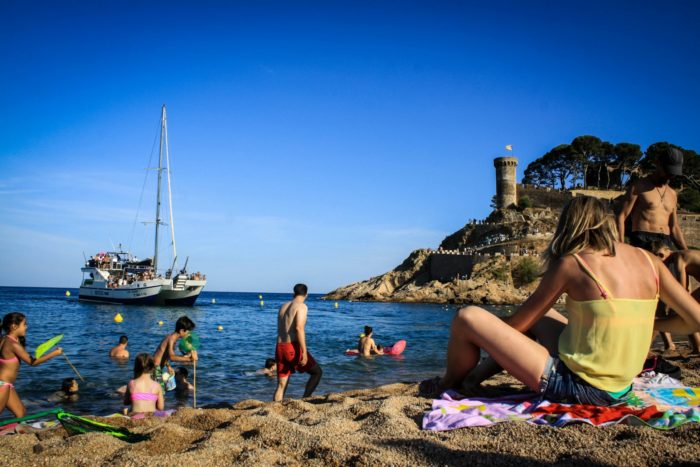
Tossa de Mar’s main beach: Photo by Andrea Huls Pareja.
Nestled along the north-eastern coast of Spain, the Costa Brava remains one of the most picturesque and enchanting regions in Catalonia. Known for its rugged cliffs, crystal-clear waters, and whitewashed towns, this area captivates visitors with its natural beauty and vibrant cultural tapestry. The Costa Brava is not just a destination; it is an experience that offers a profound connection to its historical roots, artistic influences, and the Mediterranean lifestyle.
As we embark on this journey through Costa Brava, we’ll explore a curated selection of must-visit towns and villages, each with its own unique character and appeal. From the historic streets of Tossa de Mar to the artistic enclaves of Cadaqués, and the hidden coves of Aiguablava, this guide aims to reveal the essence of Costa Brava. Whether you seek the tranquillity of secluded beaches, the thrill of historical discovery, or the warmth of small-town hospitality, this region promises a treasure trove of experiences.
Join us as we delve into the heart of Costa Brava, where every corner holds a story, every landscape inspires awe, and every moment becomes a cherished memory. Let this guide be your companion in uncovering the best places to visit, ensuring an unforgettable journey along one of Spain’s most beloved coastlines.
Top destinations: must-visit towns and villages
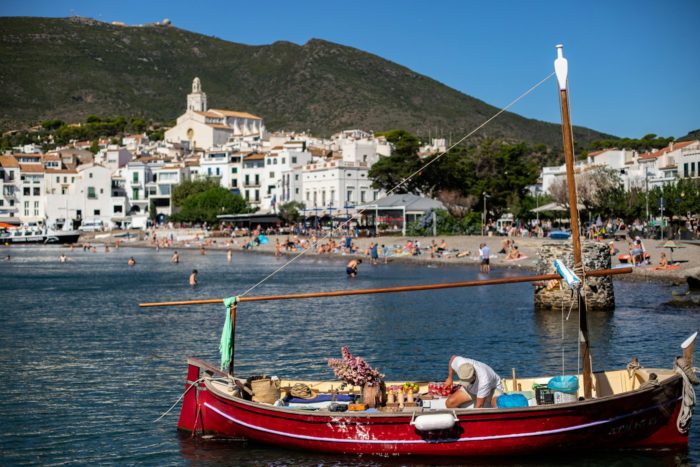
The picturesque village of Cadaqués: Photo by David Monje
Tossa de Mar: Often heralded as the jewel of Costa Brava, Tossa de Mar is an enchanting mix of ancient history and modern-day allure. The town is famed for its well-preserved medieval castle that towers over the bay, offering panoramic views of the azure Mediterranean. The beaches here, such as Platja Gran, are nestled between rugged cliffs, providing a perfect setting for a day under the sun. The vibrant local life, with its bustling markets and cosy seaside restaurants, invites visitors to indulge in the local cuisine and enjoy the laid-back atmosphere.
Llafranc: This elegant seaside resort is less about crowds and more about serene beauty. Llafranc is beloved for its refined charm, with a promenade that is perfect for leisurely walks at sunset. The marina adds a touch of glamour, while the nearby Cap Roig provides spectacular coastal views and lush botanical gardens that host an annual music festival, blending nature with cultural festivities. The British novelist Tom Sharpe, known for his satirical works, lived in Llafranc for many years.
Cadaqués: Known as the home of Salvador Dalí, Cadaqués is a living canvas, with its white-washed houses and cobblestone streets that have inspired artists for generations. The town’s bohemian spirit is palpable in its art galleries and workshops, while the surrounding natural parks offer stunning landscapes to explore. The waterfront is lined with cafes and restaurants where one can savour fresh seafood while overlooking the tranquil sea.
Sant Feliu de Guíxols: This town combines sandy beaches with cultural richness, anchored by the Monastery of Sant Feliu, an architectural marvel that dates back to the Romanesque period. The town’s promenade is a hub of activity, offering everything from beach bars to art exhibitions, making it a perfect spot for those who want a vibrant seaside experience combined with historical exploration. Just a short distance away, the beaches of Sant Pol and S’Agaró offer stunning vistas and refined elegance, with beautifully paved walkways ideal for a leisurely stroll along the sea.
L’Escala: Renowned for its anchovies and maritime heritage, L’Escala is a delightful blend of old and new. The town is gateway to the ruins of Empúries, where one can walk through the Greco-Roman archaeological site (see below). Back in town, the beaches like Riells and Cala Montgó are ideal for families, offering calm waters and golden sand. The local gastronomy, particularly seafood, is not to be missed, providing a taste of the Mediterranean that is both authentic and exquisite.
Cultural hotspots and historical sites
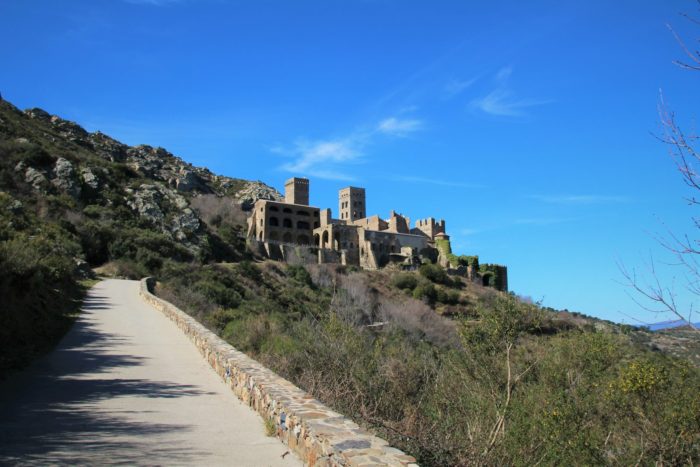
Sant Pere de Rodes monastery: Photo by Sergio Otoya
Girona: Just a short journey inland from the bustling beaches of Costa Brava lies Girona, a city that boasts a rich tapestry of history woven into its ancient walls. The Jewish Quarter is one of the best-preserved in Europe, offering narrow alleys and historical buildings that tell the stories of centuries past. The majestic Girona Cathedral stands as a beacon of architectural grandeur, dominating the cityscape with its imposing presence. For a taste of local life, the vibrant weekly markets and festivals provide a colourful backdrop to this historic city.
The ruins of Empúries: This is a site where history comes alive by the sea. The ruins are unique, showcasing layers of Greek and Roman history side by side. Visitors can stroll through the remains of temples, forums, and mosaic-laden houses, which offer a rare glimpse into ancient civilizations. The adjacent museum complements the outdoor sites with artifacts and detailed exhibits, enhancing the educational experience.
Sant Pere de Rodes Monastery: Perched dramatically on the hills of the Cap de Creus, the monastery offers not only a spiritual retreat but also panoramic views of the coastline below. The complex dates back to the 10th century and features a blend of Romanesque and Gothic architectural styles. A visit here is as much a journey through scenic landscapes as it is a step back into medieval Catalonia.
Dalí Triangle: The Dalí Triangle is a fascinating cultural journey that takes visitors through three pivotal locations in Salvador Dalí’s life. The journey begins at the Dalí Theatre-Museum in Figueres, which stands as the heart of the Dalí Triangle. This museum, designed by Dalí himself, is a surreal journey into the artist’s mind, serving both as a monumental piece of art and a home to a broad range of works spanning his career. A short drive from Cadaqués brings you to Portlligat, where Dalí’s former residence and studio sit nestled in a small cove. This house has been preserved as a museum and reveals a labyrinth of quirky rooms and passageways, each decorated with Dalí’s unique touch, providing deep insights into his personal life and creative process. The journey culminates at Púbol, in the Castle of Gala Dalí. This castle, a romantic gift from Dalí to his wife Gala, now serves as a museum dedicated to their life together, displaying various pieces of Dalí’s art, opulent decorations, and personal artifacts that have been left much as they were.
Peratallada: Known for its striking medieval architecture, this town is a jewel in the heart of Costa Brava. The fortified stone walls and meticulously preserved buildings transport visitors back to the Middle Ages. The town’s narrow streets lead to quaint cafes and artisan shops, offering a peaceful escape and a step back in time.
Pals: Another mediaeval gem, Pals is characterized by its cobblestone streets, gothic windows, and stone archways. The town is particularly famous for its tower, Torre de les Hores, which provides a commanding view of the Empordà region. Pals is not only a historical site but also a vibrant centre of cultural activities, including music festivals and craft markets.
Hidden gems and lesser-known locations
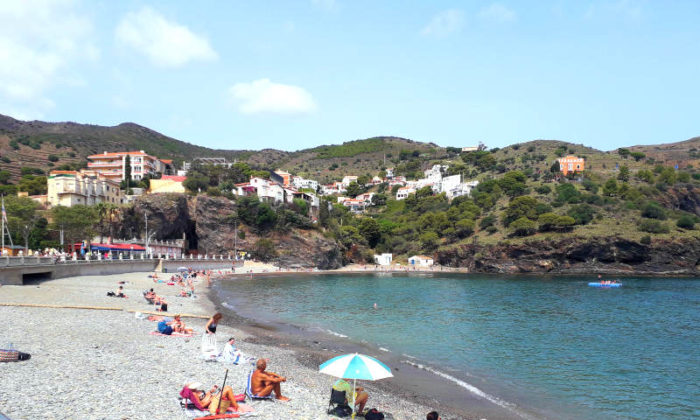
Portbou in August: Photo by David Leigh
Port de la Selva: Tucked away on the northern coast of Costa Brava, Port de la Selva is a serene fishing village that offers a quiet escape from the more tourist-heavy spots. Its rugged coastline is dotted with small beaches and coves that are perfect for those seeking solitude. The town is also a starting point for several hiking trails that lead to secluded monasteries and ancient hermitages, offering both natural beauty and a touch of history.
Portbou: Near the French border, Portbou is a small town that often goes unnoticed by the typical tourist circuit. Its location provides spectacular views of the Mediterranean and the surrounding mountains. The town has a poignant historical significance with the Walter Benjamin Memorial, dedicated to the German Jewish philosopher who tragically died here while fleeing the Nazis. Portbou is ideal for history buffs and those looking for a peaceful coastal retreat.
Tamariu: This little cove, known for its clear blue waters and sheltered beach, is ideal for families and anyone looking to escape the hustle and bustle. The beach is lined with charming restaurants that serve fresh seafood caught daily by the local fishermen. Tamariu is perfect for snorkelling, offering visitors a more intimate experience with nature.
Aiguablava: Not far from Begur, Aiguablava is famed for its stunning turquoise waters and fine sandy beaches, making it one of the most picturesque spots in Costa Brava. Despite its beauty, it remains less crowded than other beaches, offering a tranquil atmosphere. The surrounding cliffs provide excellent hiking opportunities, with trails leading to breath-taking overlooks.
Begur: A hilltop town known for its medieval castle, Begur offers panoramic views of the Costa Brava coastline. The town itself is vibrant, with a lively market square surrounded by colourful colonial-style houses—a legacy of locals who migrated to Cuba and later returned. Begur’s nightlife is surprisingly vibrant, with several chic bars and clubs that blend traditional Catalan charm with modern luxury.
Practical travel tips
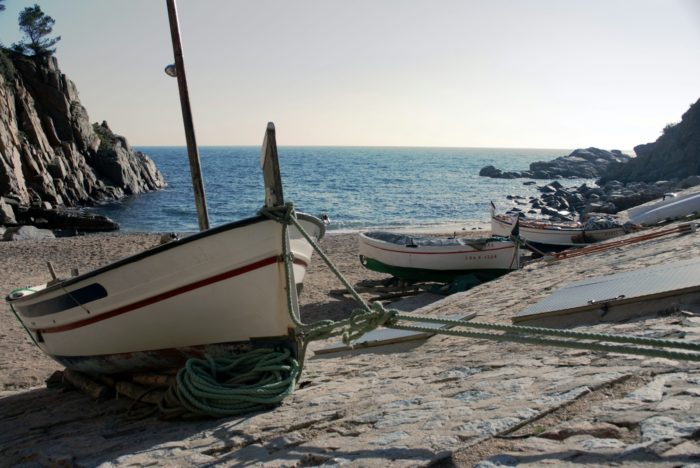
Photo by Bruno Hervas
Best times to visit: Costa Brava enjoys a Mediterranean climate, making it a year-round destination. However, the ideal time to visit is from late spring to early autumn (May through September), when the weather is warm and the waters are perfect for swimming. If you prefer to avoid the peak tourist season, consider visiting in late spring (May to June) or early autumn (September to October), when the crowds are fewer and the temperatures are still pleasant.
Transportation: Getting around Costa Brava is straightforward, thanks to its well-connected roads and public transportation system. Renting a car is highly recommended if you plan to explore the hidden gems and lesser-known towns, as it provides the flexibility to travel at your own pace. For those preferring public transport, bus services connect the major towns and villages along the coast but some routes are only daily. Additionally, the area is served by the train line that runs from Barcelona to Portbou, stopping at various points along the way.
Accommodation: Costa Brava offers a wide range of accommodation to suit all preferences and budgets. From luxury resorts and boutique hotels in major towns like Tossa de Mar and Cadaqués to charming guesthouses and vacation rentals in quieter locales like Tamariu and Aiguablava. For an authentic experience, consider staying in a rural house or masia in the countryside, which often offers stunning settings and traditional Catalan hospitality.
Local customs and etiquette: The Catalans are proud of their culture and language. While Spanish is widely spoken, knowing a few phrases in Catalan can be appreciated. In dining, meals are typically later than in many other countries, with lunch around 2 pm and dinner not before 8 pm. Tipping is customary but not obligatory; rounding up the bill or leaving a few coins is generally sufficient.
Safety and health: Costa Brava is considered a safe destination for tourists. However, it’s always advisable to have travel insurance and be aware of your surroundings, especially in crowded places. Sun protection is crucial, especially in summer, and staying hydrated is important during outdoor activities.
Local delicacies: The region is known for its rich gastronomy, characterized by seafood and traditional Catalan dishes. Don’t miss trying suquet de peix (fish stew), escalivada (roasted vegetables), and crema catalana (Catalan cream) for dessert. Local wines and cava should also be sampled to complement your meals.
The timeless charm of the Costa Brava
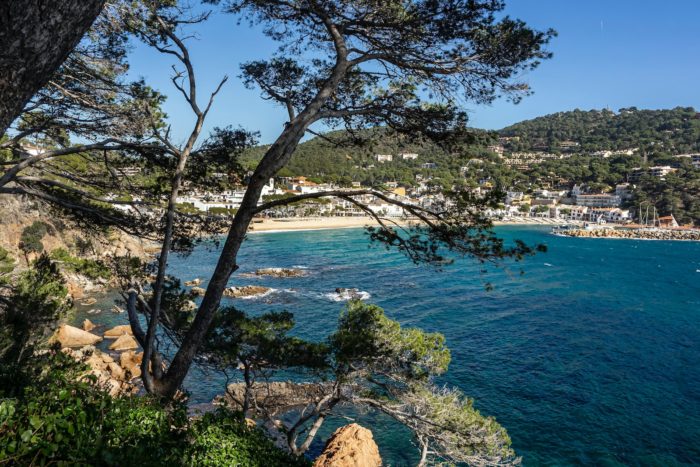
A view of Llafranc. Photo by Manuel Torres Garcia
Costa Brava, with its enchanting blend of sun-drenched beaches, medieval towns, and artistic heritage, offers an unrivalled tapestry of experiences that cater to every kind of traveller. From the lively streets of Tossa de Mar to the tranquil coves of Aiguablava, and the surreal landscapes of the Dalí Triangle, this region promises a journey filled with diversity and discovery.
As you explore Costa Brava, you are invited to delve deeper into its cultural richness, uncover hidden gems, and immerse yourself in the local lifestyle. Whether you are seeking relaxation on secluded beaches, adventures in historic settings, or culinary delights in rustic villages, Costa Brava has something special to offer.
We hope this guide inspires you to plan your visit and explore the many facets of this beautiful region. Remember to embrace the local culture, respect the natural environment, and most importantly, take the time to enjoy the unique moments that Costa Brava provides.
For more insights and detailed guides to each destination mentioned, don’t forget to sign up for our newsletter. Dive deeper into the wonders of Costa Brava and let this vibrant coastline be your next unforgettable escape.

